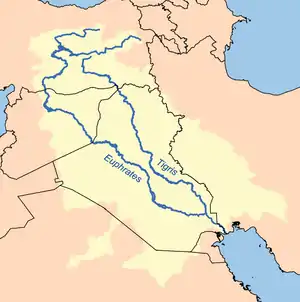Diyarbakır
Diyarbakır (Kurdish: Amed,[2] Zaza: Diyarbekir,[3] Armenian: Տիգրանակերտ, lit. 'Tigranakert';[4] Syriac: ܐܡܝܕ, romanized: Āmīd[5]) is one of the largest cities in Turkey. Situated around a high plateau by the banks of the Tigris river on which stands the historic Diyarbakır Fortress, it is the administrative capital of the Diyarbakır Province of south-eastern Turkey. It is the third-largest city in Turkey's Southeastern Anatolia Region, after Şanlıurfa and Gaziantep. The site was formerly the ancient city of Amida, and was of great importance in the Roman–Persian Wars, and during Late Antiquity was re-fortified with city walls by the Roman emperor; these walls remain standing.
Diyarbakır | |
|---|---|
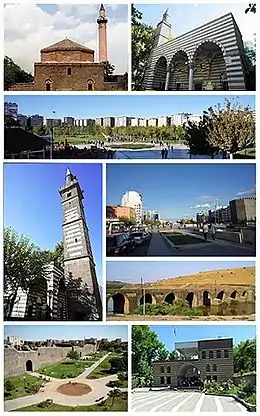 Top left: Ali Pasha Mosque, Top right: Nebi Mosque, 2nd: Seyrangeha Park, 3rd left: Dört Ayaklı Minare Mosque, 3rd upper right: Deriyê Çiyê, 3rd lower right: On Gözlü Bridge (or Silvan Bridge), over Tigris River, Bottom left: Diyarbakır City Wall, Bottom right: Gazi Köşkü (Veterans Pavilion) | |
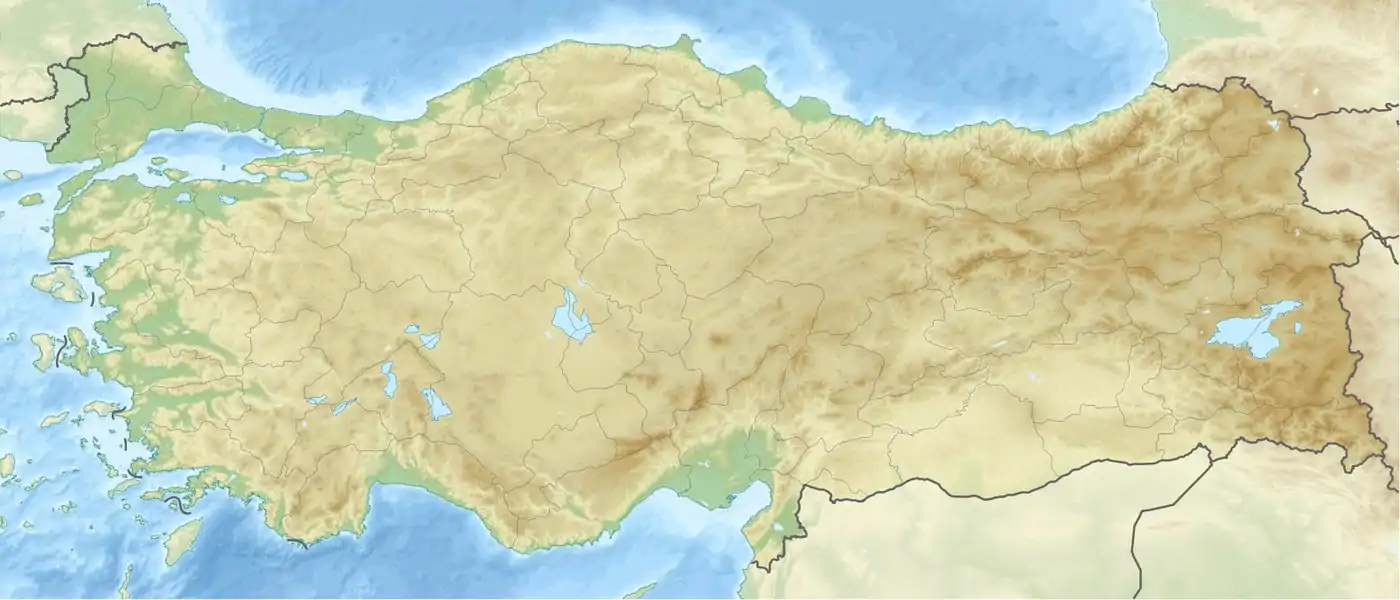 Diyarbakır Location of Diyarbakır within Turkey 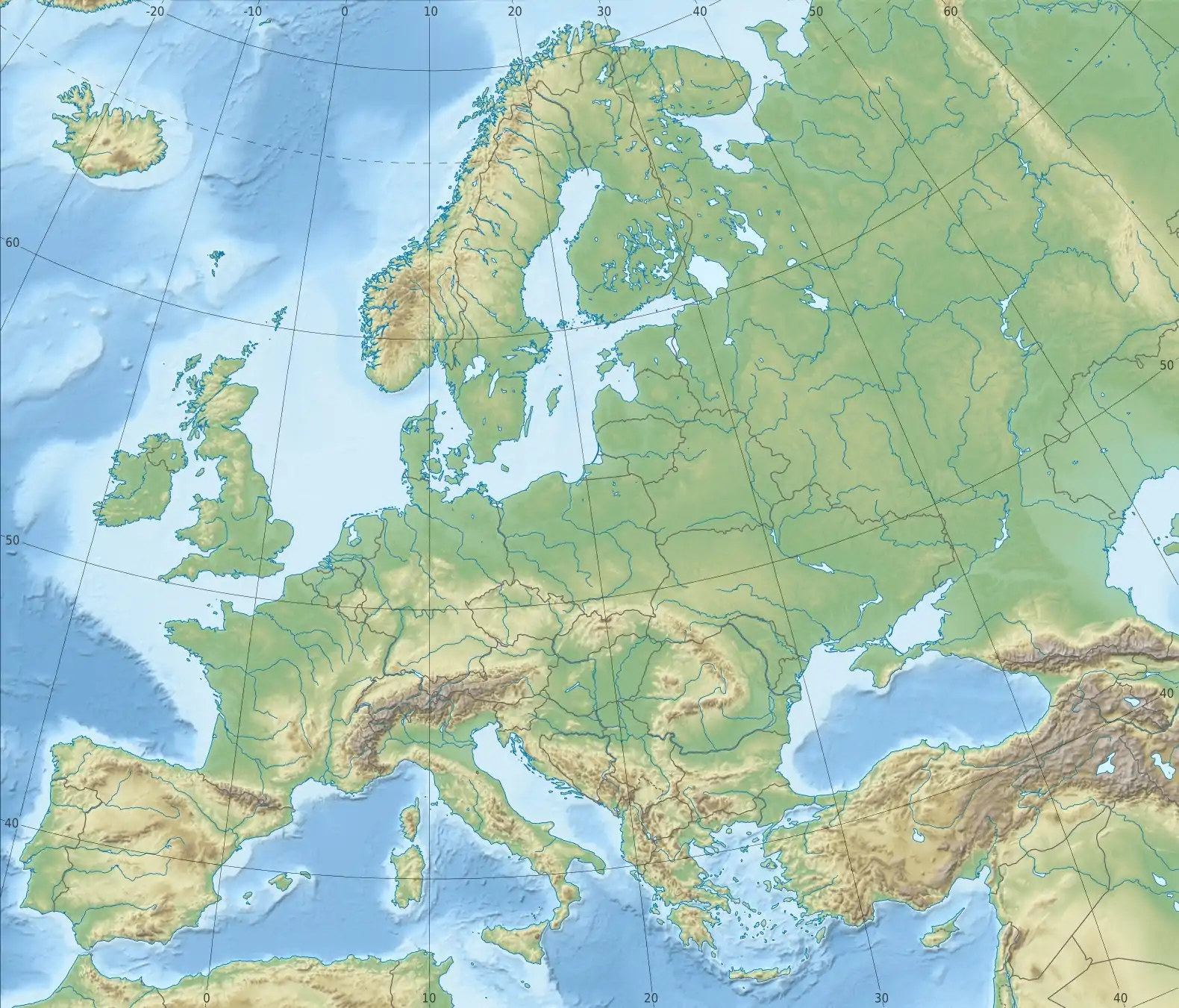 Diyarbakır Diyarbakır (Europe) 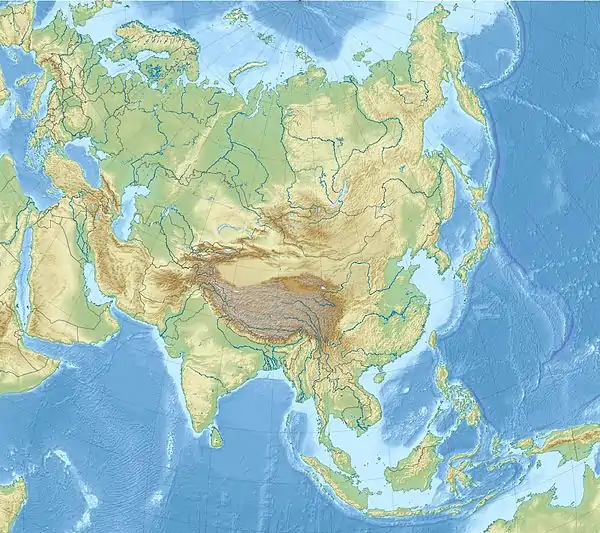 Diyarbakır Diyarbakır (Asia) .svg.png.webp) Diyarbakır Diyarbakır (Earth) | |
| Coordinates: 37.91°N 40.24°E | |
| Country | |
| Region | Southeastern Anatolia |
| Province | Diyarbakır |
| Government | |
| • Mayor | Münir Karaloğlu (state-appointed) |
| Elevation | 675 m (2,215 ft) |
| Population (2018)[1] | |
| • Total | 1,723,396 |
| Time zone | UTC+3 (TRT) |
| Postal code | 21x xx |
| Area code(s) | 412 |
| Licence plate | 21 |
| Website | www.diyarbakir.gov.tr |
According to the Synecdemus of Hierocles, as Amida, Diyarbakır was the major city of the Roman province of Mesopotamia.[6] It was the episcopal see of the Christian diocese of Mesopotamia.[6] Ancient texts record that ancient Amida had an amphitheatre, thermae (public baths), warehouses, a tetrapylon monument, and Roman aqueducts supplying and distributing water.[7] The Roman historian Ammianus Marcellinus was serving in the late Roman army during the Siege of Amida by the Sasanian Empire under Shapur II (r. 309–379), and described the successful siege in detail.[7] Amida was then enlarged by refugees from ancient Nisibis (Nusaybin), which the emperor Jovian (r. 363–364) was forced to evacuate and cede to Shapur's Persians after the defeat of his predecessor Julian's Persian War, becoming the main Roman stronghold in the region.[7] The chronicle attributed to Joshua the Stylite describes the capture of Amida by the Persians under Kavad I (r. 488–531) in the second Siege of Amida in 502–503, part of the Anastasian War.[7]
Either the emperor Anastasius Dicorus (r. 491–518) or the emperor Justinian the Great (r. 527–565) rebuilt the walls of Amida, a feat of defensive architecture praised by the Greek historian Procopius.[7] As recorded by the works of John of Ephesus, Zacharias Rhetor, and Procopius, the Romans and Persians continued to contest the area, and in the Byzantine–Sasanian War of 602–628 Amida was captured and held by the Persians for twenty-six years, being recovered in 628 for the Romans by the emperor Heraclius (r. 610–641), who also founded a church in the city on his return to Constantinople (Istanbul) from Persia the following year.[6][7] In 639, as part of the Muslim conquest of the Levant during the early Arab–Byzantine wars, Amida fell to the armies of the Rashidun Caliphate led by Iyad ibn Ghanm, and the Great Mosque of Amida was constructed afterwards in the city's centre, possibly on the site of the Heraclian Church of Saint Thomas.[6][7] There were as many as five Christian monasteries in the city, including the Zuqnin Monastery and several ancient churches mentioned by John of Ephesus.[7] One of these, the Church of the Virgin Mary, remains the city's cathedral and the see of the bishop of Diyarbakır in the Syriac Orthodox Church.[7] Another ancient church, the Church of Mar Cosmas, was seen by the British explorer Gertrude Bell in 1911 but was destroyed in 1930, while the former Church of Saint George, in the walled citadel, may originally have been built for Muslim use or for the Church of the East.[7]
In Arabic the region around the city was known as Diyar Bakr. The city was part of the Umayyad Caliphate and then the Abbasid Caliphate, but then came under more local rule until its recovery in 899 by forces loyal to the caliph al-Mu'tadid (r. 892–902) before falling under the sway of first the Hamdanid dynasty and then the Buyid dynasty, followed by a period of control by the Marwanids. The city was taken by the Seljuks in 1085 and by the Ayyubids in 1183. Ayyubid control lasted until the Mongol invasions of Anatolia, and the Mongol capture of the city in 1260. Between the Mongol occupation and conquest by the Safavid dynasty of Iran, the Kara Koyunlu and Aq Qoyunlu – two Turkoman confederations – were in control of the city in succession. Diyarbakır was conquered by the Ottoman Empire in 1514 by Bıyıklı Mehmed Pasha, in the reign of the sultan Selim I (r. 1512–1520). Mohammad Khan Ustajlu, the Safavid governor of Diyarbakir, was evicted from the city and killed in the following Battle of Chaldiran in 1514.[8] Thereafter the city became the focus of the Diyarbekir Eyalet and later the Diyarbekir Vilayet. After the foundation of the Turkish Republic, Diyarbakır became the seat of the First Inspectorate-General and then the current Diyarbakır Province.
Diyarbakır has been a focal point of the conflict between the Turkish state and various Kurdish insurgent groups.[9] Many Kurds view Diyarbakır as the capital of Kurdistan.[10]
Names and etymology
The city's name (Kurdish: Amed; Turkish: Diyarbakır; Arabic: دیار بکر, Diyaru Bakr, which means the Land of Bakir; Armenian: Տիգրանակերտ, Tigranakert;[11] Ancient Greek: Άμιδα, Amida; Ottoman Turkish: دیاربکر, Diyâr-ı Bekr; Syriac: ܐܡܝܕ) is inscribed as Amed on the sheath of a sword from the Assyrian period, and the same name was used in other contemporary Syriac and Arabic works.[12] The Romans and Byzantines called the city Amida.[12] Amit is found in Empire of Trebizond official documents from 1358.[13] Among the Artukid and Akkoyunlu it was known as "Black Amid" (Kara Amid) for the dark color of its walls, while in the Zafername, or eulogies in praise of military victories, it is called "Black Fortress" (Kara Kale).[12] In the Book of Dede Korkut and some other Turkish works it appears as Kara Hamid.[12]
Following the Arab conquests in the seventh century, the Arab Bakr tribe settled in this region,[12] which became known as the Diyar Bakr ("landholdings of the Bakr tribe", in Arabic: ديار بكر, Diyar Bakr).[14][15] In November 1937, Turkish President Mustafa Kemal Atatürk visited the city and, after expressing uncertainty on the exact etymology of the city, in December of the same year ordered that it be renamed "Diyarbakır", which means "land of copper" in Turkish after the abundant resources of copper around the city.[16]
History
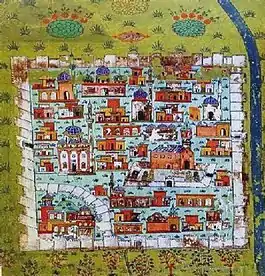
Antiquity
The area around Diyarbakır has been inhabited by humans from the Stone Age.
The first major civilization to establish itself in the region of Diyarbakır was the Hurrian kingdom of the Mitanni. It was then ruled by a succession of nearly every polity that controlled Upper Mesopotamia, including the Arameans, Assyrians, Urartu, Armenians, Achaemenid Persians, Medes, Seleucids, and Parthians.[17] The Roman Republic gained control of the city in 66 BC, by which stage it was named "Amida".[18] In 359, Shapur II of Persia captured Amida after a siege of 73 days.[19]
Ecclesiastical history
Syriac Christianity took hold in the region between the 1st and 4th centuries AD, particularly amongst the Assyrians of the city. The Byzantine Emperor Theodosius II (408–450) divided the Roman province of Mesopotamia into two, and made Amida the capital of Mesopotamia Prima, and thereby also the metropolitan see for all the province's bishoprics.[20]
At some stage, Amida became a see of the Armenian Church. The bishops who held the see in 1650 and 1681 were in full communion with the Holy See, and in 1727 Peter Derboghossian sent his profession of faith to Rome. He was succeeded by two more bishops of the Armenian Catholic Church, Eugenius and Ioannes of Smyrna, the latter of whom died in Constantinople in 1785. After a long vacancy, three more bishops followed. The diocese had some 5,000 Armenian Catholics in 1903,[21] but it lost most of its population in the 1915 Armenian Genocide. The last diocesan bishop of the see, Andreas Elias Celebian, was killed with some 600 of his flock in the summer of 1915.[22][23][24][25]
An eparchy for the local members of the Syriac Catholic Church was established in 1862. Persecution of Christians in the Ottoman Empire during the First World War brought an end to the existence of both these Syrian residential sees.[22][23][26][27]
In 1966, the Chaldean Catholic Archeparchy of Amida, with jurisdiction over all Chaldean Catholics in Turkey, was revived in Diyarbakır, with the city being both episcopal see and location of the diocesan cathedral of St. Mary Church, Diyarbakır. As of 2015, there are two Chaldean churches and three Armenian churches in at least periodic operation. Three other churches are in ruins, all Armenian: one in Sur, Diyarbakır, one in the citadel that is now part of a museum complex, and one in another part of the city.
Middle Ages
In 639, the city was captured by the Muslim conquests, and introduced the religion of Islam. The city passed under Umayyad and then Abbasid control, but with the progressive fragmentation of the Abbasid Caliphate from the late 9th century, it periodically came under the rule of autonomous dynasties. Isa ibn al-Shaykh al-Shaybani and his descendants ruled the city and the wider Diyar Bakr from 871 until 899, when Caliph al-Mu'tadid restored Abbasid control, but the area soon passed to another local dynasty, the Hamdanids. The latter were displaced by the Buyids in 978, who were in turn followed by the Marwanids in 983. The Marwanids ruled until 1085, the Seljuks took the city from the Marwanids in 1085, the city came under the rule of the Mardin branch of the Oghuz Turks and then the Anatolian beylik of the Artuqids. The city came under the Ayyubid Sultanate in 1183 and ruled the city until it was taken over by the Mongols in 1260, the city was taken over by the competing Turkic federations of the Kara Koyunlu (the Black Sheep) first and then the Aq Qoyunlu until the rise of the Persian Safavids, who naturally took over the city and the wider region.
Safavids and Ottomans
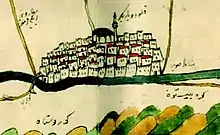
The Classical Age of the Ottoman Empire saw it expand into Western Armenia and all but the eastern regions of Kurdistan at the expense of the Safavids. From the early 16th century, the city and the wider region was the source of intrigue between the Safavids and the Ottoman Empire, both of whom sought the support of the Kurdish chieftains around Idris Bitlisi.[8] It was conquered by the Ottoman Empire in 1514 in the campaigns of Bıyıklı Mehmed Pasha, under the rule of Sultan Selim I. Mohammad Khan Ustajlu, the Safavid Governor of Diyarbakir, was evicted from the city and killed in the following Battle of Chaldiran in 1514.[8]
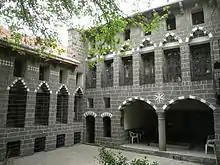
Following their victory, the Ottomans established the Diyarbekir Eyalet with its administrative centre in Diyarbakır. The Eyalet of Diyarbakır corresponded to today's Turkish Kurdistan, a rectangular area between the Lake Urmia to Palu and from the southern shores of Lake Van to Cizre and the beginnings of the Syrian desert, although its borders saw some changes over time. The city was an important military base for controlling the region and at the same time a thriving city noted for its craftsmen, producing glass and metalwork. For example, the doors of Rumi's tomb in Konya were made in Diyarbakır, as were the gold and silver decorated doors of the tomb of Ebu Hanife in Baghdad. Ottoman rule was confirmed by the 1555 Peace of Amasya which followed the Ottoman–Safavid War (1532–1555).
Concerned with independent-mindedness of the Kurdish principalities, the Ottomans sought to curb their influence and bring them under the control of the central government in Constantinople. However, removal from power of these hereditary principalities led to more instability in the region from the 1840s onwards. In their place, sufi sheiks and religious orders rose to prominence and spread their influence throughout the region. One of the prominent Sufi leaders was Shaikh Ubaidalla Nahri, who began a revolt in the region between Lakes Van and Urmia. The area under his control covered both Ottoman and Qajar territories. Shaikh Ubaidalla is regarded as one of the earliest proponents of Kurdish nationalism. In a letter to a British Vice-Consul, he declared: "The Kurdish nation is a people apart... we want our affairs to be in our hands."
In 1895 an estimated 25,000 Armenians and Assyrians were massacred in Diyarbekir Vilayet, including in the city.[28] At the turn of the 19th century, the Christian population of the city was mainly made up of Armenians and Syriac Orthodox Christians.[29] The city was also a site of ethnic cleansing during the 1915 Armenian and Assyrian Genocide; nearly 150,000 were expelled from the city to the death marches in the Syrian desert.[30]
Republic of Turkey
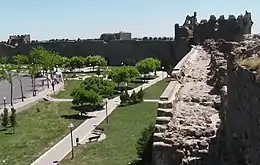
.jpg.webp)
In January 1928, Diyarbakır became the center of the First Inspectorate-General, a regional subdivision for an area containing the provinces of Hakkari, Van, Şırnak, Mardin, Siirt, Bitlis and Şanlıurfa. In a reorganization of the provinces in 1952, Diyarbakır city was made the administrative capital of the Diyarbakır Province. In 1993, Diyarbakir was established as a Metropolitan Municipality.[31] Its districts are Baĝlar, Bismil, Ergani, Hazro, Kayapinar, Çermik, Çinar, Eğil, Dicle, Kulp, Kocaköy, Lice, Silvan, Sur, Yenişehir and Hani.[32]
Diyarbakır grew from a population of 30,000 in the 1930s to 65,000 by 1956, to 140,000 by 1970, to 400,000 by 1990,[33] and eventually swelled to about 1.5 million by 1997.[34] During the 1980s and 1990s, at the peak of the Kurdish-Turkish conflict, the population of the city grew dramatically, due to the thousands of Kurdish villages depopulated by Turkey.
The American-Turkish Pirinçlik Air Force Base near Diyarbakır, was operational from 1956–1997.
Diyarbakır has seen much violence in recent years, involving Turkish security forces, the Kurdistan Workers Party (PKK), and the Islamic State of Iraq and the Levant (ISIL).[35][36][37] Between 8 November 2015 and 15 May 2016 large parts of Sur were destroyed in fighting between the Turkish military and the PKK.[38]
A 2018 report by Arkeologlar Derneği İstanbul found that, since 2015, 72% of the city's historic Sur district had been destroyed through demolition and redevelopment, and that laws designed to protect historic monuments had been ignored. They found that the city's "urban regeneration" policy was one of demolition and redevelopment rather than one of repairing cultural assets damaged during the recent civil conflict, and because of that many registered historic buildings had been completely destroyed. The extent of the loss of non-registered historic structures is unknown because any historic building fragments revealed during the demolition of modern structures were also demolished.[39]
Sports
The most notable football clubs of the city are Diyarbakırspor (established 1968) and Amed SK (established 1990).[40]
The women's football team Amed SFK were promoted at the end of the 2016–17 Turkish Women's Second Football League season to the Women's First League.[41]
Politics
In the 2014 local elections, Gültan Kışanak and Fırat Anlı of the Peace and Democracy Party (BDP) were elected co-mayors of Diyarbakır. However, on 25 October 2016, both were detained by Turkish authorities "on thinly supported charges of being a member of the Kurdistan Workers Party (PKK)".[42] The Turkish government ordered a general internet blackout after the arrest.[43] Nevertheless, on 26 October, several thousand demonstrators at Diyarbakir city hall demanded the mayors' release.[42] Some days later, the Turkish government appointed an unelected state trustee as the mayor.[44] In November, public prosecutors demanded a 230-year prison sentence for Kışanak.[45]
In January 2017, the Turkish government appointed unelected state trustee ordered the removal of the Assyrian sculpture of a mythological winged bull from the townhall, which had been erected by the BDP mayors to commemorate the Assyrian history of the town and its still resident Assyrian minority.[46][47]
In the Municipal election 2019 Adnan Selçuk Mızraklı was elected mayor of Diyarbakir[48] In August 2019 he was dismissed, accused of supporting terrorism.[49]
Economy
Historically, Diyarbakır produced wheat and sesame.[50][51] They would preserve the wheat in warehouses, with coverings of straw and twigs from licorice trees. This system would allow the wheat to be preserved for up to ten years.[50] In the late 19th and early 20th century, Diyarbakır exported raisins, almonds, and apricots to Europe.[51] Angora goats were raised, and wool and mohair was exported from Diyarbakır. Merchants would also come from Egypt, Istanbul, and Syria, to purchase goats and sheep.[52] Honey was also produced, but not so much exported, but used by locals. Sericulture was observed in the area, too.[53]
Prior to World War I, Diyarbakır had an active copper industry, with six mines. Three were active, with two being owned by locals and the third being owned by the Turkish government. Tenorite was the primary type of copper mined. It was mined by hand by Kurds. A large portion of the ore was exported to England. The region also produced iron, gypsum, coal, chalk, lime, jet, and quartz, but primarily for local use.[54]
The city is served by Diyarbakır Airport and Diyarbakır railway station.
Demographics
Demographic history
At the turn of the 19th century, the Christian population of the city was mainly made up of Armenians and Assyrians.[29] The Assyrian and Armenian presence dates to antiquity.[55] There was also a small Jewish community in the city.[56]
Present day
According to a November 2006 survey by the Sûr Municipality, 72% of the inhabitants of the municipality use Kurdish most often in their daily speech due to the overwhelming Kurdish majority in the city [57] with small minorities of Assyrians, Armenians, Turks and Yazidis still resident. After World War II, as the Kurdish population moved to urban centres, Diyarbakir's Kurdish population continued to grow.[58] There are also several Alevi Turkmen villages around Diyarbakır old city, however there are no specific official data about the population numbers.[56][59]
Culture
Some jewelry making and other craftwork continues today although the fame of the Diyarbakır's craftsmen has long passed. Folk dancing to the drum and zurna (pipe) are a part of weddings and celebrations in the area.
Cuisine
Diyarbakır is known for rich dishes of lamb which use spices such as black pepper, sumac and coriander; rice, bulgur and butter. The most famous specialty dish from Diyarbakır is Meftune which is made up of lamb meat and vegetable laced with garlic and sumac. Another known dish is Kaburga Dolması which is a baked lamb's ribs stuffed with rice, almonds and many spices.[60] Diyarbakır is also known for its watermelons; one of the events in the city is the annually held Watermelon Festival.[61]
Main sights

The core of Diyarbakır is surrounded by an almost intact, dramatic set of high walls of black basalt forming a 5.5 km (3.4 mi) circle around the old city. There are four gates into the old city and 82 watch-towers on the walls, which were built in antiquity, restored and extended by the Roman emperor Constantius II in 349. The area inside the walls is known as the Sur district; before its recent demolition and redevelopment this district had 599 registered historical buildings.[39]
Medieval mosques and medreses
- Great Mosque of Diyarbakır built by the Seljuk Turkish Sultan Malik Shah in the 11th century. The mosque, one of the oldest in Turkey, is constructed in alternating bands of black basalt and white limestone (The same patterning is used in the 16th century Deliler Han Madrassah, which is now a hotel). The adjoining Mesudiye Medresesi/Medreseya Mesûdiyeyê was built at the same time, as was another prayer-school in the city, Zinciriye Medresesi/Medreseya Zincîriyeyê.
- Behram Pasha Mosque (Beharampaşa Camii/Mizgefta Behram Paşa) – an Ottoman mosque built in 1572 by the governor of Diyarbakır, Behram Pasha, noted for the well-constructed arches at the entrance.
- Sheikh Matar Mosque with Dört Ayaklı Minare/Mizgefta Çarling (the Four-legged Minaret) – built by Kasim Khan of the Aq Qoyunlu.
- Fatihpaşa Camii/Mizgefta Fetih Paşa – built in 1520 by Diyarbakır's first Ottoman governor, Bıyıklı Mehmet Paşa ("the moustachioed Mehmet pasha"). The city's earliest Ottoman building, it is decorated with fine tilework.
- Hazreti Süleyman Mosque/Mizgefta Hezretî Silêman (1155–1169) Süleyman son of Halid Bin Velid, who died capturing the city from the Arabs, is buried here along with his companions.
- Hüsrevpaşa Camii/Mizgefta Husrev Paşa – the mosque of the second Ottoman governor, 1512–1528. Originally the building was intended to be a school (medrese)
- İskender Paşa Camii/Mizgefta Îskender Paşa – a mosque of an Ottoman governor, an attractive building in black and white stone, built in 1551.
- Melek Ahmet Camii/Melek Ahmed Paşa a 16th-century mosque noted for its tiled prayer-niche and for the double stairway up the minaret.
- Nebii Camii/Mizgefta Pêxember – an Aq Qoyunlu mosque, a single-domed stone construction from the 16th century. Nebi Camii means "the mosque of the prophet" and is so-named because of the number of inscriptions in honour of the prophet on its minaret.
- Safa Camii/Mizgefta Palo – built in the middle of the 15th century under Uzun Hasan, ruler of the Aq Qoyunlu (White Sheep Turkomans) tribe[62] and restored in Ottoman time in 1532.
Churches
- St. Giragos Armenian Church – first built in 1519, the current structure is from 1883, and was recently restored after a long period of disuse.[63]
- The Syriac Orthodox Church of Our Lady (Syriac: ܐ ܕܝܠܕܬ ܐܠܗܐ `Idto d-Yoldat Aloho, Turkish: Meryemana kilisesi), was first constructed as a pagan temple in the 1st century BCE. The current construction dates back to the 3rd century, has been restored many times, and is still in use as a place of worship today.
- Mar Petyun (St. Anthony) Chaldean Catholic Church, built in 1681.[63]
- Surp Sarkis Chaldean Church[64]
- St. Marys Cathedral
- There are a few other churches in the city
Museums
- The Archaeological Museum contains artifacts from the neolithic period, through the Early Bronze Age, Assyrian, Urartu, Roman, Byzantine, Artuqids, Seljuk Turk, Aq Qoyunlu, and Ottoman Empire periods.
- Cahit Sıtkı Tarancı Museum – the home of the late poet and a classic example of a traditional Diyarbakır home.
- The birthplace of poet Ziya Gökalp – preserved as a museum to his life and works.
- Ahmet Arif Literature Museum Library
Other historical buildings
- The Dicle Bridge, an 11th-century bridge with ten arches
- The Diyarbakır Fortress and Hevsel Gardens Cultural Landscape were elected an UNESCO World Heritage in 2015 and are popular tourist attractions.[65]
Climate
Diyarbakır has a Mediterranean climate (Köppen climate classification Csa). Summers are very hot and very dry, due to its location on the Mesopotamian plain which is subject to hot winds from the deserts of Syria and Iraq to the south. The highest recorded temperature was 46.2 °C (112.64 °F) on 21 July 1937. Winters are cold with moderate precipitation and frosty nights. Snowfall is quite common between the months of December and March, snowing for a week or two. The lowest recorded temperature was −24.2 °C (−10.12 °F) on 11 January 1933. Highest recorded snow depth was 65 cm (25.6 inches) on 16 January 1971.
| Climate data for Diyarbakır (1960–2012) | |||||||||||||
|---|---|---|---|---|---|---|---|---|---|---|---|---|---|
| Month | Jan | Feb | Mar | Apr | May | Jun | Jul | Aug | Sep | Oct | Nov | Dec | Year |
| Record high °C (°F) | 16.9 (62.4) |
21.8 (71.2) |
28.3 (82.9) |
35.3 (95.5) |
39.8 (103.6) |
42.0 (107.6) |
46.2 (115.2) |
45.9 (114.6) |
42.0 (107.6) |
35.7 (96.3) |
28.4 (83.1) |
22.5 (72.5) |
46.2 (115.2) |
| Average high °C (°F) | 6.7 (44.1) |
8.9 (48.0) |
14.5 (58.1) |
20.2 (68.4) |
26.5 (79.7) |
33.7 (92.7) |
38.4 (101.1) |
38.1 (100.6) |
33.2 (91.8) |
25.2 (77.4) |
16.1 (61.0) |
9.2 (48.6) |
22.6 (72.6) |
| Daily mean °C (°F) | 1.8 (35.2) |
3.5 (38.3) |
8.5 (47.3) |
13.8 (56.8) |
19.3 (66.7) |
26.3 (79.3) |
31.2 (88.2) |
30.3 (86.5) |
24.8 (76.6) |
17.2 (63.0) |
9.2 (48.6) |
4.0 (39.2) |
15.8 (60.5) |
| Average low °C (°F) | −2.3 (27.9) |
−1.1 (30.0) |
2.7 (36.9) |
7.1 (44.8) |
11.4 (52.5) |
17.0 (62.6) |
21.8 (71.2) |
21.1 (70.0) |
16.1 (61.0) |
10.2 (50.4) |
3.9 (39.0) |
−0.1 (31.8) |
9.0 (48.2) |
| Record low °C (°F) | −24.2 (−11.6) |
−21.0 (−5.8) |
−14.0 (6.8) |
−6.1 (21.0) |
0.8 (33.4) |
1.8 (35.2) |
9.9 (49.8) |
11.4 (52.5) |
0.0 (32.0) |
−1.8 (28.8) |
−12.9 (8.8) |
−23.4 (−10.1) |
−24.2 (−11.6) |
| Average precipitation mm (inches) | 68.0 (2.68) |
68.8 (2.71) |
67.3 (2.65) |
68.7 (2.70) |
41.3 (1.63) |
7.9 (0.31) |
0.5 (0.02) |
0.4 (0.02) |
4.1 (0.16) |
34.7 (1.37) |
51.8 (2.04) |
71.4 (2.81) |
484.9 (19.1) |
| Average rainy days | 12.2 | 11.8 | 11.8 | 12.0 | 8.9 | 2.9 | 0.5 | 0.3 | 1.2 | 6.1 | 8.0 | 11.5 | 87.2 |
| Average relative humidity (%) | 75 | 72 | 67 | 65 | 59 | 43 | 31 | 31 | 35 | 51 | 69 | 75 | 56 |
| Mean monthly sunshine hours | 120.9 | 134.4 | 173.6 | 207.0 | 300.7 | 366.0 | 387.5 | 362.7 | 297.0 | 229.4 | 162.0 | 117.8 | 2,859 |
| Source 1: Devlet Meteoroloji İşleri Genel Müdürlüğü | |||||||||||||
| Source 2: Weatherbase[66] | |||||||||||||
Notable people born in the city
- Aëtius of Amida, (5th century to mid-6th century) a Greek medical writer and court physician at Constantinople.[67][68][69]
- Abdülkadir Aksu, former interior minister
- Ahmed Arif, poet
- Pınar Ayhan, singer, Turkish representative at the Eurovision Song Contest 2000
- Aziz Yıldırım, President of Fenerbahçe S.K. sports club
- Cahit Sıtkı Tarancı, poet
- Cihan Haspolatlı, footballer for Galatasaray S.K.
- Ephraim of Amida, Chalcedonian Christian theologian, comes orientis (523–524; 526) and patriarch of Antioch (527–545).[70]
- Gazi Yaşargil, medical scientist and neurosurgeon
- Hesenê Metê, writer
- Hovsep Pushman, Armenian-American painter
- Hikmet Çetin, former foreign minister and former NATO Senior Civilian Representative in Afghanistan
- Leyla Zana, politician
- Yekta Uzunoglu,[71] writer, physician, human rights fighter, translator and entrepreneur.
- Lokman Polat, writer
- Agop Handanyan, physician and writer
- Mehmed Emin Bozarslan, writer
- Mehmet Polat, actor
- Kevork Malikyan, actor
- Naum Faiq, Assyrian writer and founding father of modern Assyrian nationalism
- Osman Baydemir: Kurdish politician
- Rupen Zartarian, Armenian writer
- Rojen Barnas, writer
- Songül Öden, actress
- Süleyman Nazif, poet
- Theodota of Amida, Syriac Orthodox holy man, monk, and bishop of Amida (died 698).[72]
- Thomas of Amida, monk, city councillor, chorepiscopus and bishop of Amida (505–519).[73]
- Ziya Gökalp, sociologist and writer (the Ziyagökalp neighborhood of the city is named after him, as well as many streets and schools)
- Mıgırdiç Margosyan, writer
- Coşkun Sabah, musician
- Sayf al-Din al-Amidi, Islamic theologian and legal scholar of the Shafi'i school
- Zabelle C. Boyajian, Armenian painter and writer
See also
References
- "Diyarbakir".
- Avcýkýran, Dr. Adem (ed.). "Kürtçe Anamnez, Anamneza bi Kurmancî" (PDF). Tirsik. p. 55. Retrieved 17 December 2019.
- Zazaca -Türkçe Sözlük, R. Hayıg-B. Werner
- Western Armenian pronunciation: Dikranagerd; Hovannisian, Richard G. (2006). Armenian Tigranakert/Diarbekir and Edessa/Urfa. Costa Mesa, California: Mazda Publishers. p. 2. ISBN 978-1-56859-153-7.
The city that later generations of Armenians would call Dikranagerd was actually ancient Amid or Amida (now Diyarbekir or Diyarbakır), a great walled city with seventy-two towers...
- "J. Payne Smith (Mrs. Margoliouth), A Compendious Syriac Dictionary (Oxford: The Clarendon Press, 1903) p. 19 [from sedra.bethmardutho.org, tagged by George A. Kiraz, accessed on May. 20, 2020]".
- Nicholson, Oliver (2018), Nicholson, Oliver (ed.), "Mesopotamia, Roman", The Oxford Dictionary of Late Antiquity (online ed.), Oxford University Press, doi:10.1093/acref/9780198662778.001.0001/acref-9780198662778-e-3135, ISBN 978-0-19-866277-8, retrieved 28 November 2020
- Keser-Kayaalp, Elif (2018), Nicholson, Oliver (ed.), "Amida", The Oxford Dictionary of Late Antiquity (online ed.), Oxford University Press, doi:10.1093/acref/9780198662778.001.0001/acref-9780198662778-e-207, ISBN 978-0-19-866277-8, retrieved 28 November 2020
- Özoğlu, Hakan (12 February 2004). Kurdish Notables and the Ottoman State: Evolving Identities, Competing Loyalties, and Shifting Boundaries. SUNY Press. pp. 47–49. ISBN 978-0-7914-5993-5.
- https://www.middleeasteye.net/news/tensions-increase-already-fragile-kurdish-peace-process-faulters-turkey
- https://www.nytimes.com/2016/12/24/world/europe/an-aleppo-like-landscape-in-a-kurdish-redoubt-of-turkey.html
- Western Armenian pronunciation: Dikranagerd; Hovannisian, Richard G. (2006). Armenian Tigranakert/Diarbekir and Edessa/Urfa. Costa Mesa, California: Mazda Publishers. p. 2. ISBN 978-1-56859-153-7.
The city that later generations of Armenians would call Dikranagerd was actually ancient Amid or Amida (now Diyarbekir or Diyarbakır), a great walled city with seventy-two towers...
- Diyarbakır Archived 23 December 2011 at the Wayback Machine. Turkish Airlines. Retrieved 2012-05-13.
- Zehiroglu, Ahmet M. ; "Trabzon Imparatorlugu" 2016 (ISBN 978-605-4567-52-2) ; p.223
- Abdul- Rahman Mizouri Taj Al- Arifeen: Udday bin Musafir Al- Kurdy Al- Hakary Is not an Umayyad. Part Two. College of Arts/ Dohuk University (2001)
- Verity Campbell (1 April 2007). Turkey. Lonely Planet. pp. 621–. ISBN 978-1-74104-556-7. Retrieved 13 May 2012.
- See Üngör, Uğur (2011), The Making of Modern Turkey: Nation and State in Eastern Anatolia, 1913–1950. Oxford: Oxford University Press, p. 244. ISBN 0-19-960360-X.
- Trevor Bryce, The Kingdom of the Hittites, 1999 p. 137
- Theodor Mommsen History of Rome, The Establishment of the Military Monarchy. Italian.classic-literature.co.uk. Retrieved 2012-05-13.
- The Eye of Command, Kimberly Kagan, p. 23
- Edwards, Robert W., "Diyarbakır" (2016). The Eerdmans Encyclopedia of Early Christian Art and Archaeology, ed., Paul Corby Finney. Grand Rapids, Michigan: William B. Eerdmans Publishing. p. 115. ISBN 978-0-8028-9016-0.
- Annuaire Pontifical Catholique, 1903, p. 173.
- Pius Bonifacius Gams, Series episcoporum Ecclesiae Catholicae, Leipzig 1931, p. 456
- Pius Bonifacius Gams, Series episcoporum Ecclesiae Catholicae, Complementi, Leipzig 1931, p. 93
- F. Tournebize, v. Amid ou Amida, in Dictionnaire d'Histoire et de Géographie ecclésiastiques, vol. XII, Paris 1953, coll. 1246–1247
- Hovhannes J. Tcholakian, L'église arménienne catholique en Turquie, 1998
- S. Vailhé, Antioche. Patriarcat syrien-catholique, in Dictionnaire de Théologie Catholique, Vol. I, Paris 1903, coll. 1433
- O. Werner, Orbis terrarum catholicus, Freiburg 1890, p. 164
- Gunter, Michael (1999). The Kurdish Predicament in Iraq: A Political Analysis. p. 8. ISBN 978-0-312-21896-6.
- Joost Jongerden; Jelle Verheij (2012). Social Relations in Ottoman Diyarbekir, 1870–1915. BRILL. p. 20. ISBN 978-90-04-22518-3.
- Dumper, Michael (2007). Cities of The Middle East and North Africa: A Historical Encyclopedia. p. 130. ISBN 978-1-57607-919-5.
- "504 Sayılı Kanun Hükmünde Kararname | Kanunlar". 3 February 2014. Archived from the original on 3 February 2014. Retrieved 10 November 2019.
- "Diyarbakır Seçim Sonuçları – 31 Mart 2019 Yerel Seçimleri". sabah.com.tr. Retrieved 10 November 2019.
- McDowall, David (2004). 3E (ed.). A Modern History of the Kurds. IB Tauris. p. 403. ISBN 978-1-85043-416-0.
- Kirişci, Kemal (June 1998). "Turkey". In Janie Hampton (ed.). Internally Displaced People: A Global Survey. London: Earthscan Publications Ltd. pp. 198, 199.
- "Death toll in HDP Diyarbakır rally rises to three – Turkey News". Hürriyet Daily News. Retrieved 10 November 2019.
- "ISIL claims Diyarbakir bombing days after 'al-Baghdadi urged attacks on Turkey'". euronews. 4 November 2016. Retrieved 10 November 2019.
- "Roadside bomb blast kills police in Turkey's Diyarbakir". www.aljazeera.com. Retrieved 23 January 2020.
- Turkije, Lucas Waagmeestercorrespondent in. "Vernietiging Turkse steden veel groter dan gedacht". nos.nl.
- Diyarbakir Ziyareti: Çatişma, Yikim ve Yeniden İnşa
- "Turkish court acquits German footballer Naki in Kurdish case". BBC. 8 November 2016.
- "are-your-ancesters-from-dikrranagerr". westarmgen. 4 September 2018. Retrieved 4 September 2018.
- "Fury erupts after mayors detained in Turkey's Kurdish southeast". Al-Monitor. 26 October 2016.
- "Slowdown in access to social media in Turkey a 'security measure,' says PM". Hurriyet Daily News. 4 November 2016.
- "Turkey appoints trustee as Diyarbakir mayor after arrests". France24. 1 November 2016. Archived from the original on 30 November 2016.
- "Prosecutors demand 230 years prison sentences for ousted Diyarbakır Co-Mayor Kışanak". Hurriyet Daily News. 29 November 2016.
- "Turkey: the AKP launches a campaign against the Assyrian Christians". Voltairenet. 17 January 2017.
- "Turkey remove Assyrian sculpture from front of local city hall". Almasdar News. 17 January 2017.
- "Diyarbakır Seçim Sonuçları – 31 Mart Diyarbakır Yerel Seçim Sonuçları". secim.haberler.com (in Turkish). Retrieved 20 May 2019.
- "Three pro-Kurdish mayors replaced in southeastern Turkey". Middle East Eye. Retrieved 19 August 2019.
- Prothero, W.G. (1920). Armenia and Kurdistan. London: H.M. Stationery Office. p. 60.
- Prothero, W.G. (1920). Armenia and Kurdistan. London: H.M. Stationery Office. p. 62.
- Prothero, W.G. (1920). Armenia and Kurdistan. London: H.M. Stationery Office. p. 63.
- Prothero, W.G. (1920). Armenia and Kurdistan. London: H.M. Stationery Office. p. 64.
- Prothero, W.G. (1920). Armenia and Kurdistan. London: H.M. Stationery Office. p. 70.
- Goodspeed, George (1902). A History of the Babylonians and Assyrians, Volume 6.
- Konu: Diyarbakır Tarihi ve Demografik Yapısı
- "Belediye Diyarbakırlıyı tanıdı: Kürtçe konuşuyor". Radikal (in Turkish). Dogan News Agency. 24 November 2006. Archived from the original on 30 September 2007. Retrieved 6 August 2008.
- Metin Heper; Sabri Sayari (7 May 2013). The Routledge Handbook of Modern Turkey. Routledge. p. 247. ISBN 978-1-136-30964-9.
It was thus only in recent times that Diyarbakır, the unofficial capital of Turkey's Kurdish area, became a predominantly Kurdish town.
- Diyarbakır Alevi-Türkmen köyleri
- "Selim Amca'nın Sofra Salonu". Lonely Planet.
- "Diyarbakır Culture and Watermelon Festival". arastirma.tarimorman.gov.tr. Retrieved 9 September 2019.
- Tile Revetments from the 15th Century in Eastern Anatolia : A Problem of Attribution, Khalida Mahi [Ancient Cities], 2011,
- "Diyarbakir – Other monuments". romeartlover.tripod.com.
- "Churches of Diyarbakir also expropriated". Agos. Retrieved 9 September 2019.
- Centre, UNESCO World Heritage. "Diyarbakır Fortress and Hevsel Gardens Cultural Landscape". UNESCO World Heritage Centre. Retrieved 9 September 2019.
- Historical Weather for Diyarbakir, Turkey – Travel, Vacation, Forecast and Reference Information. Weatherbase. Retrieved 2012-05-13.
- Plant, Ian Michael (2004). Women Writers of Ancient Greece and Rome: An Anthology. University of Oklahoma Press. p. 229. ISBN 978-0-8061-3621-9.
Aetius: A Greek from Amida (in Mesopotamia), who wrote on philosophy in the mid- sixth century AD in Alexandria.
- Meade, Richard Hardaway (1968). An introduction to the history of general surgery. Saunders. p. 108. OCLC 438114.
Aetius of Amida, who lived in the sixth century A.D. and was the first Greek physician who was a Christian, had a chapter on aneurysms in his book on surgery.
- Pormann, Peter E. (2018), Nicholson, Oliver (ed.), "Aëtius of Amida", The Oxford Dictionary of Late Antiquity (online ed.), Oxford University Press, doi:10.1093/acref/9780198662778.001.0001/acref-9780198662778-e-99, ISBN 978-0-19-866277-8, retrieved 15 December 2020
- Mellon Saint-Laurent, Jeanne-Nicole (2018), Nicholson, Oliver (ed.), "Ephrem of Amida", The Oxford Dictionary of Late Antiquity (online ed.), Oxford University Press, doi:10.1093/acref/9780198662778.001.0001/acref-9780198662778-e-1666, ISBN 978-0-19-866277-8, retrieved 15 December 2020
- "home". Yekta Uzunoglu. Retrieved 10 August 2018.
- Tannous, Jack (2018), Nicholson, Oliver (ed.), "Theodota of Amida", The Oxford Dictionary of Late Antiquity (online ed.), Oxford University Press, doi:10.1093/acref/9780198662778.001.0001/acref-9780198662778-e-4704, ISBN 978-0-19-866277-8, retrieved 15 December 2020
- Greatrex, Geoffery (2018), Nicholson, Oliver (ed.), "Thomas of Amida", The Oxford Dictionary of Late Antiquity (online ed.), Oxford University Press, doi:10.1093/acref/9780198662778.001.0001/acref-9780198662778-e-4749, ISBN 978-0-19-866277-8, retrieved 15 December 2020
Sources
- Faroqhi, Suraiya (2009). Frisch, Shelley (ed.). The Ottoman Empire: A Short History. Markus Wiener Publishers. ISBN 978-1-55876-449-1.
External links
| Wikimedia Commons has media related to Diyarbakır. |
| Wikivoyage has a travel guide for Diyarbakir. |
- (in Turkish) Governorship of Diyarbakır
- (in Turkish) Diyarbakırspor funs, news, informarmation
- (in Turkish) YerelNET Diyarbakır
- (in Turkish) Information on Diyarbakır
- Over 1000 well-organized pictures of major sights

